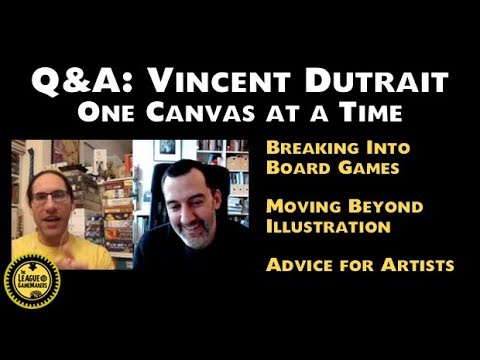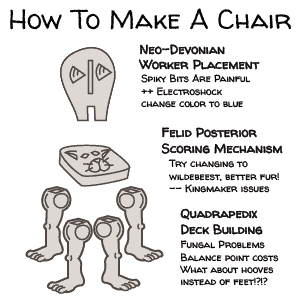
So you’re building a chair. You put together some legs, a seat, and a back, and some armrests.
It’s finally ready, so you have a few people over to sit in it and tell you what they think. Then you go back to the chair, and based on your friends’ feedback, you decide to replace the legs. They don’t really work with the rest of the chair. The new legs are much better.
The next time you test it, you realize that the seat doesn’t really match the legs anymore. But you really like those legs, and that seat was never the highlight of your design. So you replace it with a new seat. And you might as well replace that back while you’re at it.
On your next playtest — er, I mean, sitting-test — you realize those legs aren’t going to cut it. So you try on some new ones.
Rinse, repeat. Eventually, you find you’ve replaced every part of the chair multiple times, and you’re no closer to having a finished design than when you started.
You are now stuck in an endless trek through design space. You can explore until the heat-death of universe, and you still will not have discovered all of its territories. You can replace every part of that chair, over and over, in a never-ending search for the best design.
I suffer from this problem a lot when I’m designing. For years, it prevented me from ever getting a playable design. I think I’ve finally found a technique, or perhaps just a frame of mind, that seems to really help.
STEP I: WANDERING IS GOOD
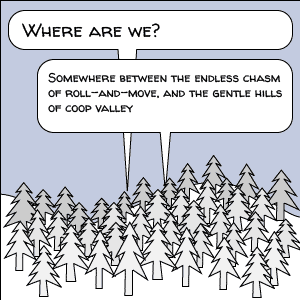
First of all, don’t be afraid to replace parts of the chair over and over again. That’s how you find cool mechanics. Rip out that deck of cards and replace it with custom dice. Eliminate that tedious worker placement board and try a bidding system. Go crazy with that deck building thing you were idly contemplating.
But your wandering should have a mission! That mission is NOT to find the perfect combination of systems. This way, madness lies! If every part of your game is up for change, you could easily be sifting the near-infinite sea of game mechanics forever. Your mission, at this point, is to find what I call your design landmark.
STEP II: CHOOSE YOUR LANDMARK
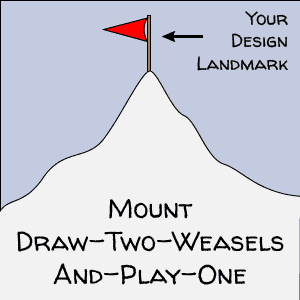
The idea is to narrow your search on one thing — just one thing — that fits your theme and experience perfectly. I tend to stumble upon these after a few cycles of undirected meanderings across the design landscape. It comes when I realize that there’s one part of the game that is the source of most of the fun.
I honestly don’t think you can find your design landmark from the blueprints; it’s something you discover from the field testing. For me, they’re never the parts of the game that I initially think are the most clever or elegant; they’re always some emergent behavior that only comes to the forefront during playtesting.
Some examples:
IN ARS VICTOR,
the Glory Track quickly became my design landmark. I added and removed a lot of different systems from Ars Victor, but it was the Glory Track that ended up being the focus of the game. Once that was established, everything else in the game was geared towards enhancing that focus.
HUNDRED KINGS WAR
has gone through several major changes in mechanics. I’ve gone through three or four completely different systems for “how players fight over things”. Finally, out of nowhere, I discovered the perfect scoring mechanic. When I chose that as my design landmark, everything else became easy.
I’VE WANDERED FOR MANY MILES ACROSS THE DESIGN LANDSCAPE WITH COMMIES!
I’ve swapped out the parts of that chair so many times, it’s unrecognizable. A few iterations ago, I realized that the most fun in the game came from the Blame system. No matter how crappy the other parts of the game have been, the Blame system has consistently been a source of fun for everyone. I’m still replacing other parts of the chair, but that part ain’t changing.
When you find a part of a design that just fits the theme and experience perfectly, nail it down. Plant a flag. Draw a line in the sand. Mark your territory. Put a big old “X” on the map. Congratulations — you’ve just chosen your design landmark!
STEP III: FINISHING THE DESIGN
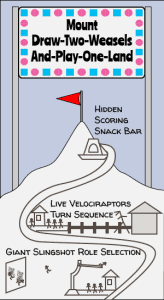
Now you finish the rest of the design: but no matter how far you meander across the design landscape, always keep your chosen landmark in sight!
Design decisions should be much easier now, because you have a fixed star by which to compare all your other systems. You’ve limited your search space from “interesting mechanics” down to “interesting mechanics that work with my design landmark”. The choice is no longer based on an amorphous “is this a good system”; you now have a concrete foundation, and the rest of your game has to actually work with that foundation.
WHEN I WAS DEVELOPING ARS VICTOR,
I had a “Stealth” system that used decoy pieces to simulate fog of war. It was clever. It was interesting. But the amount of extra rules weight that players had to deal with did nothing to focus the game on the Glory Track. Once I chose that as my design landmark, the decision to cut the Stealth system was easy. Similarly, I had an Army Powers system at one point — until I decided that it just got in the way of the Glory Track, and axed it.
HUNDRED KINGS WAR
This game went through similar transformations once I decided on the scoring system as my design landmark. I threw away an entire card-driven-wargame that I’d built (including ~60 cards with special actions) and replaced it with a fast, tense, hidden bidding system that focuses player attention on the scoring. The complex strength-point-and-leader drafting system got replaced by a simple card draw. The game has transformed from a 4+ hour slog into a ~2 hour strategic blitz.
I’VE JUST RECENTLY NAILED DOWN THE DESIGN LANDMARK FOR COMMIES!
I have just started another overhaul. I’m not sure that the new systems I’m trying are going to work — but I now have something to judge them by. I’m not just asking, “do I like this worker-placement system”, I’m now asking if it supports the design landmark I’ve chosen.
STEP IV: DON’T CHANGE IT!!!
Once you’ve chosen your design landmark, don’t change it!
Sure, you can tweak it a little if you need to, but don’t replace or abandon it. Your choice is immutable. If you change it, it wasn’t really immutable, was it? You’ve actually been at Step I this entire time, and only pretending that you made it all the way to Step III. Don’t lie to yourself like that!
If you find some cool system that replaces your design mechanic and you absolutely have to go with it, it’s a new design. Treat it like one. Shelve all the work you’ve done so far and start designing a new game.

